Slack Chat: What's Desert Living Got to Do With Good Eating?
Using Slack, a team-oriented messaging app, local experts discuss the history, culture, and science of food production in Tucson, the United States’ only designated UNESCO City of Gastronomy. The transcript of their conversation has been lightly edited.
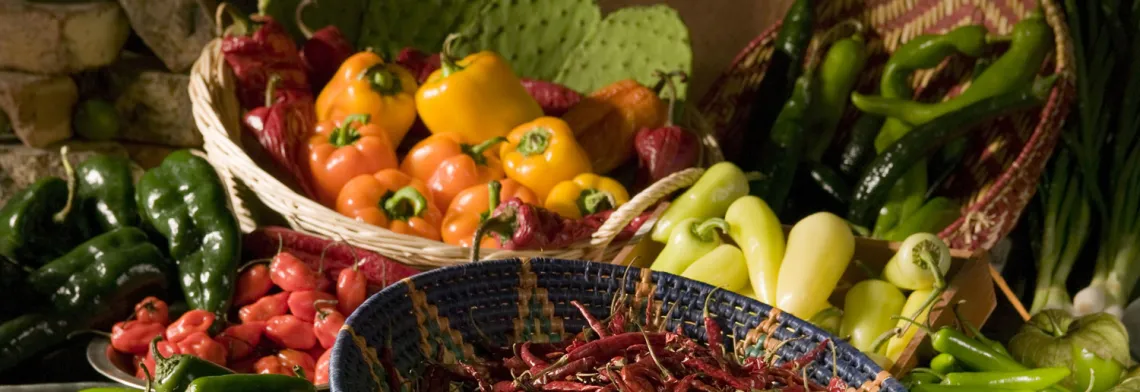
Who are we talking with?
Chaz Shelton (merchantsgarden): Chaz Shelton is the owner of Merchant’s Garden, which aims to make farm-fresh food affordable and accessible for city dwellers by using a sustainable soil-less growing technique called aquaponics. His business serves schools, grocery stores, and restaurants, including Tucson’s much-loved Downtown Kitchen & Cocktails.
Gene Giacomelli (ceac): Gene Giacomelli is the director of the Controlled Environment Agriculture Center at the University of Arizona, and a professor in the Agricultural and Biosystems Engineering Department. Giacomelli has designed, constructed, and operated various types of environmentally-controlled greenhouses utilizing hydroponic-based crop production systems for lettuce, tomatoes, strawberries, and numerous other crops.
Jonathan Mabry (jonathanbmabry): Jonathan manages historic preservation, archaeological compliance, and heritage-based economic development for the City of Tucson. His archaeological investigations have documented new information about the transition to agriculture and development of prehistoric irrigation in the U.S.-Mexico borderlands. He coauthored the successful application for UNESCO designation of Tucson as a City of Gastronomy in 2015. He is the City of Tucson liaison with the UNESCO Creative Cities Network.
Emily Litvack (elitvack): Emily Litvack is a science writer for UA Research, Discovery & Innovation. Here, she serves as moderator.
The Chat
elitvack: Hi, Chaz, Gene, and Jonathan! What brings us here today is food, which is awesome, because who among us doesn’t love food? The University of Arizona is located in Tucson, Arizona. But unbeknownst to most people, Tucson’s food scene is seriously one-of-a-kind. So, let’s talk about the history, culture, and science of food production in Tucson, shall we?
ceac: Sure!
elitvack: First things first: Gastronomy is “the practice or art of choosing, cooking, and eating good food.” Lots of cities in the United States take gastronomy quite seriously, right? So I’d like to ask frankly: What makes Tucson so special in this regard?
merchantsgarden: Tucson loves celebrating its uniqueness. Chefs, like everywhere, are trying to demonstrate their specialties in Tucson. However, here the consumer is so supportive of local.
merchantsgarden: Tucson loves Tucson and if their meal its grown in Tucson, they love it.
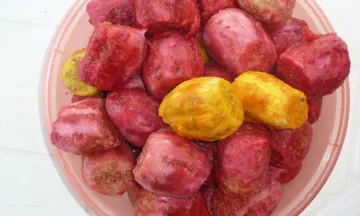
jonathanbmabry: An unusual characteristic of our food scene is the high rate of locally owned independent restaurants - 63% compared to the national average of 41%. That means more distinctive cuisine and locally sourced ingredients than national chains.
merchantsgarden: We celebrate it.
elitvack: Now we’re getting a little philosophical. Why not, right? What it is about food that works so well across so many different cultures at bringing people together? And what does gastronomy mean to you personally, in your own lives?
jonathanbmabry: Culture is mediated through food, and local and heritage foods contribute to our sense of identity and sense of place.
ceac: Producing food has been used as a means of rehabilitation; it offers satisfaction of production followed by the comfort of eating.
ceac: It is simple for me, as I just like to eat.
elitvack: Don't we all! And Tucson is a UNESCO City of Gastronomy. The only one in the United States, to be exact. What does that mean?
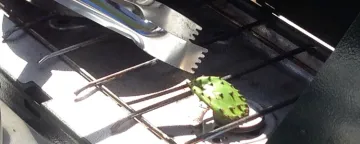
A common regional food, nopales (prickly pear cactus pads) may be eaten raw or cooked
ceac: It is an honor that Tucson was recognized. To me, it means we have special care for our food interests.
merchantsgarden: As a producer, I couldn't be more thrilled to be in the center of a place that's recognized for its food.
jonathanbmabry: When the team was compiling information about existing programs, policies, initiatives, and statistics for the application to UNESCO, we were surprised to see how much was going on. The application process itself made us more aware of our rich agricultural heritage, thriving food traditions, distinctive cuisine, cutting edge food-related research and educational programs, and innovative food policies.
Tucson Foodie Culture
ceac: It seems in the last few years that more food interests both in Tucson and beyond have entered importance in our society. People now have other reasons to travel to Tucson, other than the comfortable winter weather!
jonathanbmabry: The importance of tourism in the local economy is well known, generating an estimated $2.8 billion in direct spending and supporting over 24,000 jobs in Pima County in 2015 according to Visit Tucson.
jonathanbmabry: It is now recognized that culinary experiences are one of the top attractions for visitors, and that both tourists and residents prefer to eat at unique, independently owned restaurants—which represent one of Tucson’s largest and fastest-growing economic sectors.
elitvack: I’d love to come back to the idea of gastronomy in Tucson in a little bit. But first, I think it’s important to really dive into how we got here to begin with.
elitvack: Historically—and I mean for thousands of years—Tucson and the Sonoran Desert have been places where food production has been truly innovative and resilient, even in the face of cultural and climate change. I suspect this is a Jonathan question, too. Can you speak to that?
“Archaeologists have documented this region's deep agricultural history extends back more than 4,000 years.”
Tucson Agricultural Heritage
jonathanbmabry: Yes, over the last couple of decades archaeologists have documented this region's deep agricultural history, extending back more than 4,000 years.
jonathanbmabry: Tucson was an agricultural oasis in the desert for thousands of years. Its agricultural self-sufficiency was disrupted by the arrival of the railroad in 1880, connecting us to national and international markets. Now we are rebuilding our foodshed!
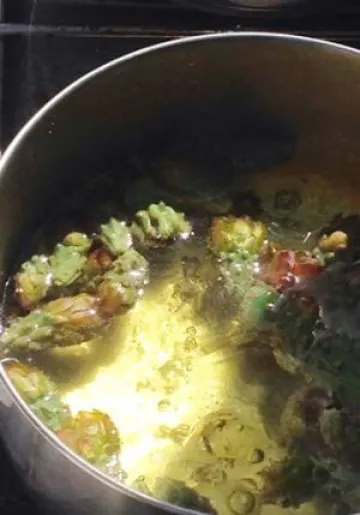
Cholla cactus buds on the boil
elitvack: And indigenous peoples were some of the earliest innovators of food production in Tucson, correct? In what ways did they make our semi-arid environment work for them?
jonathanbmabry: Among the archaeological discoveries here were buried irrigation canals. These are the earliest canals north of Mexico, and indicate that the first farmers of the Sonoran Desert learned how to manage water very effectively.
elitvack: And who exactly were the first farmers of the Sonoran Desert region? Do we know what kinds of crops they'd typically grow?
jonathanbmabry: Archaeologists are still debating whether the first farmers of our region were indigenous foragers who adopted Mesoamerican crops such as corn, beans, and squash, or were migrants from the south. But we know that they were both farming those crops that arrived from the south, and also manipulating their environments to encourage native wild food plants.
jonathanbmabry: There are many wild food resources in the Sonoran Desert that have been staples for millennia, including cactus pads, blossoms, and fruits, mesquite pods, grass seeds, edible weeds, and agave hearts.
elitvack: Love myself some cactus fruit.
"Yuma, Arizona produces roughly 90% of all lettuce eaten in the United States between November and March"
elitvack: Agriculture has become one of the biggest industries in Arizona, with an estimated $7.9 billion economic impact. On its own, Yuma, Arizona produces roughly 90% of all lettuce eaten in the United States between November and March. I’m guessing that’s counterintuitive for lots of us, because we tend to think of Arizona as hot, dry, and barren. Thoughts on why and how that came to be?
jonathanbmabry: Arizona's agriculture today, as in the past, is based on irrigation. Our irrigated agriculture has been continuous for millennia! That supplemental water can double or triple productivity, and make it economically profitable.
ceac: Water is only one part though. Sunlight is also a key factor. Plus low humidity of the air reduces crop losses to diseases. We have both in Arizona. And with transport systems, our products can help feed the country, but there is a strong movement toward locally-grown products. That’s where Chaz comes in.
elitvack: Great points, Gene. Chaz, you’re focused on bringing farming to urban communities like Tucson. And in fact, your business, Merchant’s Garden, has been literally farming the old lot for Howenstine High Magnet School, which closed in 2013. Right? What are the benefits of urban farming as you see them? I’m sure there are lots.
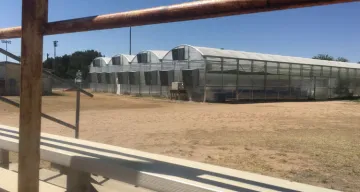
Merchant Gardeners greenhouse on an old school playground in Tucson
merchantsgarden: Yeah. We are 1.5 miles from 90% of our customers. This results in fresher products and better service.
merchantsgarden: Additionally it’s less distribution costs for us and we hold inventory for a shorter period.
Urban Agriculture
jonathanbmabry: Urban agriculture in Tucson is expanding after recent revisions in the City’s zoning regulations made it easier to grow and sell food within the city. New urban farms and “food hub” businesses are distributing locally produced foods directly and on demand to restaurants, groceries, and consumers.
ceac: Yes, the city is very supportive.
elitvack: Nice. Who are your customers, Chaz?
merchantsgarden: We have total of 30 restaurants and we are in a few local grocery stores as well as Whole Foods.
jonathanbmabry: What's next for urban agriculture?
merchantsgarden: We don’t sell direct to the public but I think that’s next for urban ag in Tucson.
ceac: Education and expansion. The interest is there, opportunities are increasing, and markets are developing.
jonathanbmabry: I think humans like to watch things grow - I do.
ceac: Yes, definitely. Especially someone who never grew before.
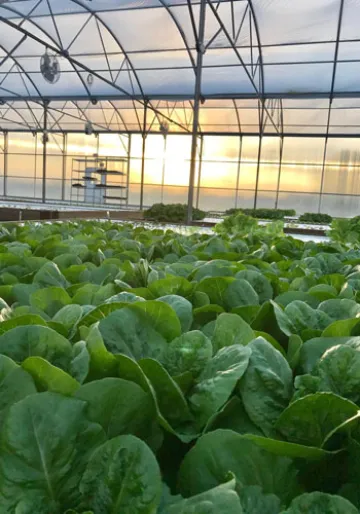
Hydroponic lettuce at Merchant Gardeners urban garden in Tucson
elitvack: Gene, I think you're totally right that the interest is increasing, even on a national level. I watch a show called Shark Tank. Entrepreneurs pitch their companies to investors, and in the last couple years I've noticed lots of companies related to gardening and urban farming.
elitvack: Thoughts on where the increased interest is coming from?
ceac: Rebound from the baby boomers who did not follow in their parents’ agricultural interests as much. They found other professions, and may have even been discouraged from doing ag. It’s hard work, yes, but also has to do with the poor economics of the business in the ‘70s. We have young people all the time who never grew a crop now wanting to learn and get into the business.
merchantsgarden: We are seeing a lot of VCs [venture capitalists] invest in ag after Blue Apron and other companies. It's the largest market in the world with huge opportunity.
ceac: Yes, Silicon Valley has found food systems. And with hydroponics and greenhouses, you don't need to own much land to get started. I’d say it’s the first time in history where your family does not have to be farmers for you to become a producer of food in a successful business.
“Local food is valued by many consumers. Local food links people to place.”
elitvack: Chaz, you provide fresh produce to the locals. Your perspective here really interests me. What motivated you to get started with Merchant's Garden?
merchantsgarden: I'm a healthcare guy. I have always been around the idea of making fresh food more accessible in urban areas. I finally said "Let's bring a farm in the city" and that's how I landed on hydroponics in a greenhouse.
ceac: And your timing was excellent!
jonathanbmabry: Local food is valued by many consumers. Local food links people to place.
jonathanbmabry: You can meet the food producer face to face at a farmers market!
elitvack: So, so true, Jonathan. Why do you all think people wanna meet their farmers?
ceac: Real people! Not a food conglomerate.
jonathanbmabry: Meeting your farmer changes it from "food from anywhere" to "food from here."
ceac: And they help you understand the challenges of producing, and the efforts they make to do so.
merchantsgarden: Great point. We are intentional about providing full transparency as to how our food is grown. Chefs really enjoy it and consumers are expecting it.
elitvack: Speaking of which, Gene and Chaz, what are some of the challenges of producing?
merchantsgarden: Cash flow and aphids.
ceac: Food availability and quality varies with seasons, and even within seasons. For example, after a huge rainstorm, products diminish. Unwanted weather is tough. And whiteflies! But at least there’s some means to limit those losses and predict harvests.
jonathanbmabry: Perhaps with climate change, urban agriculture with its controlled environments will become more critical to our food supply.
ceac: Yes and the greenhouse with climate control of indoor growing can help resolve those problems.
jonathanbmabry: The farmland is coming into the city...
ceac: Remember farmlands used to be just outside every city, and now they are called suburbs. Farms moved south and west from the north and east. Now they’re moving back to their origin, and will be inside the city, as well as in the surrounding (less costly) lands.
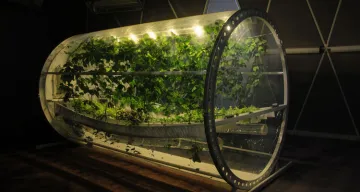
Prototype Martian Lunar greenhouse with plants growing inside
Hydroponics, UA & Space Exploration
elitvack: Okay, shifting gears here. Gene, I think one of the projects you're most well-known for is the Lunar and Martian greenhouse, which I believe is a NASA-funded project. You and I talked about this at length when The Martian movie came out. Very briefly, how does it work and what's the end goal?
ceac: Sure, yeah. It’s a hydroponic plant growth chamber. It’s centered on using plants to sustain a continuous vegetarian diet for astronauts, so in addition to crop production for food, it provides air revitalization, water recycling, and waste recycling for the crew.
ceac: It must be lightweight, compact, able to grow many crops, and recycle ALL water and nutrients, much like we must do on Earth as resources become more and more limited.
ceac: So the Mars-Lunar Greenhouse is a test not only for future life on other planets but to help us on Earth, too.
ceac: And thanks to their mutual UA affiliations, visitors can see the Mars-Lunar Greenhouse module, with plants growing inside, at Biosphere 2.
elitvack: I wanna go back to gastronomy in Tucson.
Tucson: City of Gastronomy
elitvack: Jonathan, you coauthored the application for UNESCO to make Tucson a designated City of Gastronomy. Can you talk about that process? How did the idea come about initially? What did the process involve?
jonathanbmabry: The team working on the application included heritage tourism professionals, city officials, and university faculty recruited by the pair of anthropologists leading the team - Gary Nabhan and me.
jonathanbmabry: The process involved successive applications in 2014 and 2015.
jonathanbmabry: After the first application, UNESCO sent a single-page letter indicating that Tucson was on “firm footing” in terms of meeting the designation criteria, but needed to better articulate how it would connect with other cities in the network, and encouraged reapplication (and mentioned that no city has been successful in its first try).
elitvack: Reassuring, I bet.
jonathanbmabry: We felt encouraged to re-apply, for sure.
Economic Impacts
jonathanbmabry: Now Gary and I have been measuring the impacts of the designation, and it has been very worthwhile.
jonathanbmabry: Increases in media coverage promoting tourism to Tucson (the total value increased from $5.5 million to $15.5 million in the first year) is a big one.
jonathanbmabry: Other impacts include job and business growth in the food economy, new initiatives to assist low-income residents start food businesses, and new and expanded food festivals.
jonathanbmabry: Looking at the food service permits from the County Health Department, we can see tremendous growth in many areas. The number of locally made artisanal food products has increased about 25% in one year. Number of restaurants is up 6%. Last year the number of distillers in the city doubled. We now have 17 microbreweries in the area. We now have 20 farmers markets in metro Tucson, and last year the vendor permits were up 5%.
elitvack: Jonathan, congrats. These are major successes.
elitvack: A most important two final questions for the group: Favorite Tucson eatery? What’s your favorite food?
merchantsgarden: I can’t say I have a favorite restaurant, but of course my favorite food is butter lettuce!
jonathanbmabry: The Parish, and Don Guerra's bread is my new fav.
ceac: Kingfisher or Tavolino. Pasta and a good Bolognese sauce.
elitvack: A true Italian!
elitvack: This has been such a treat, you guys. Thank you all for taking the time to join me!
ceac: Prego! Best to all.
jonathanbmabry: Have a good one, and eat local!

